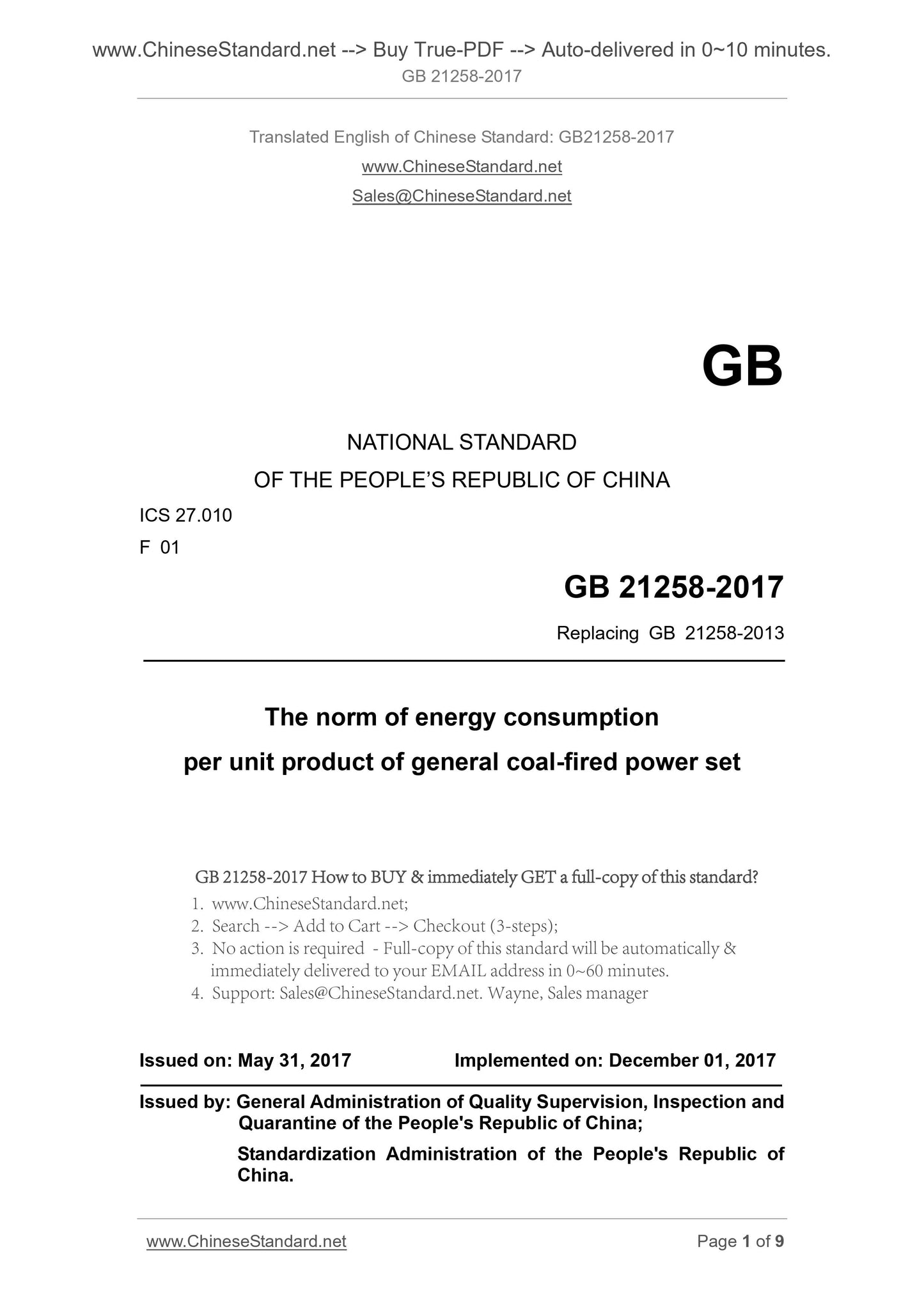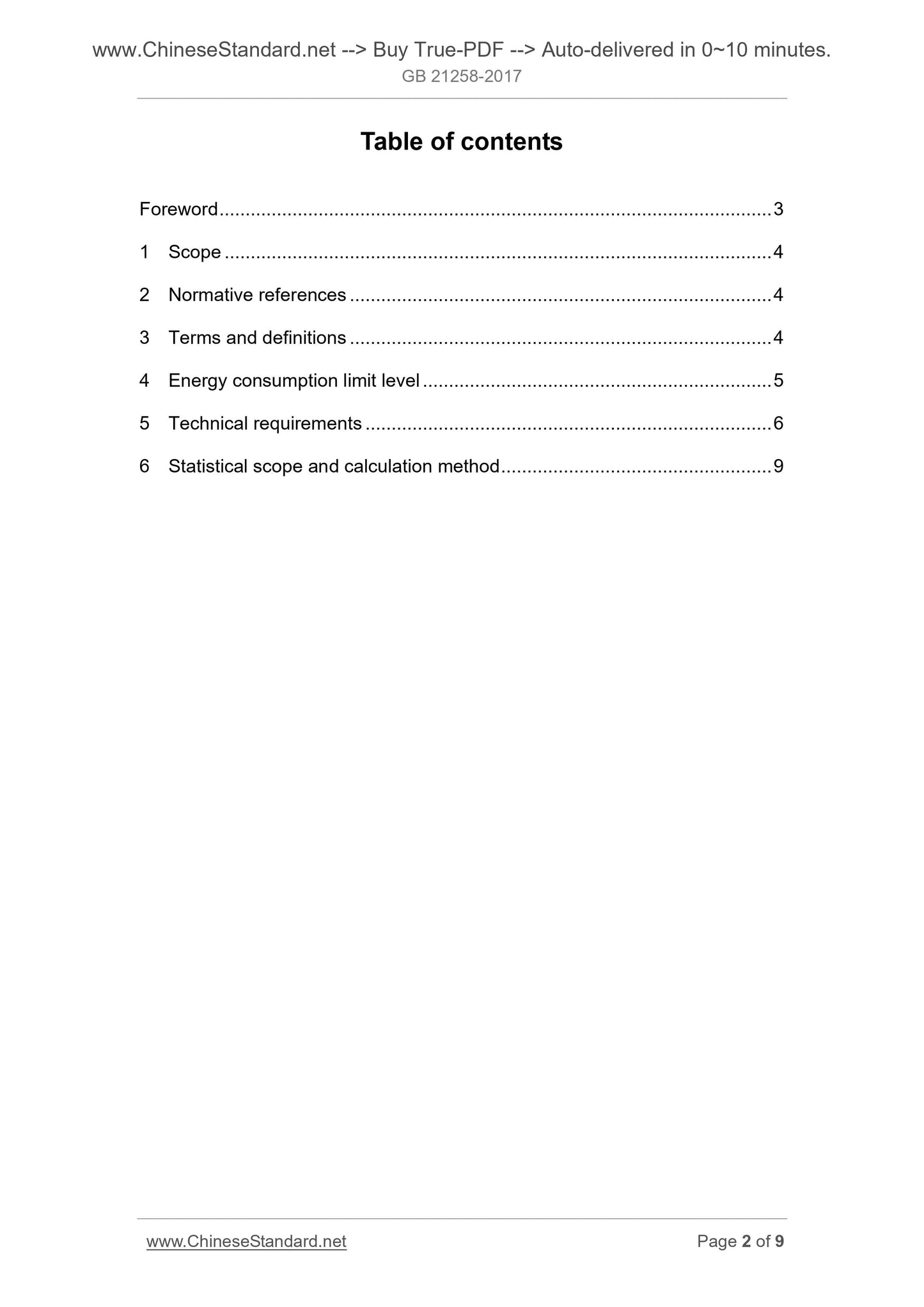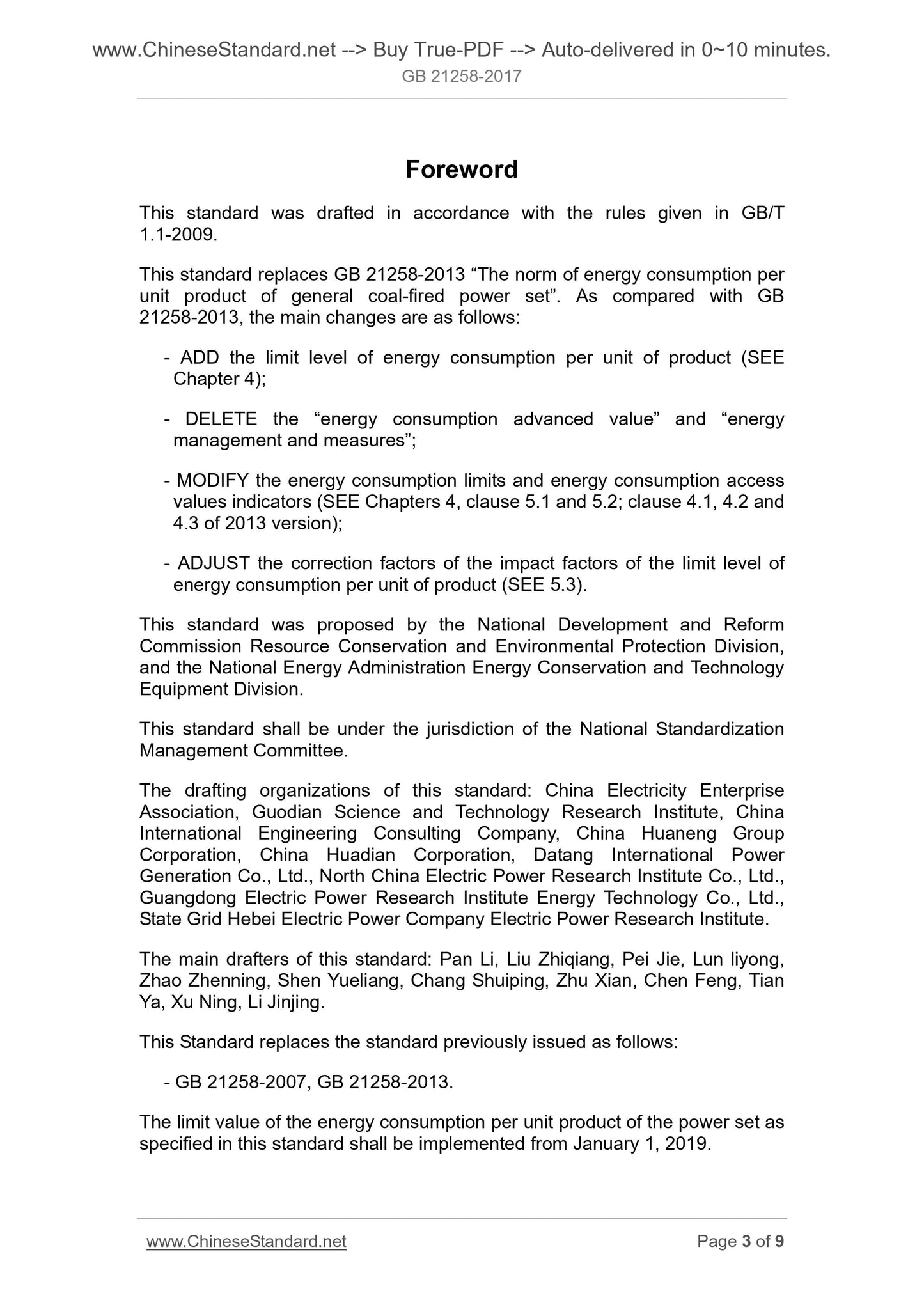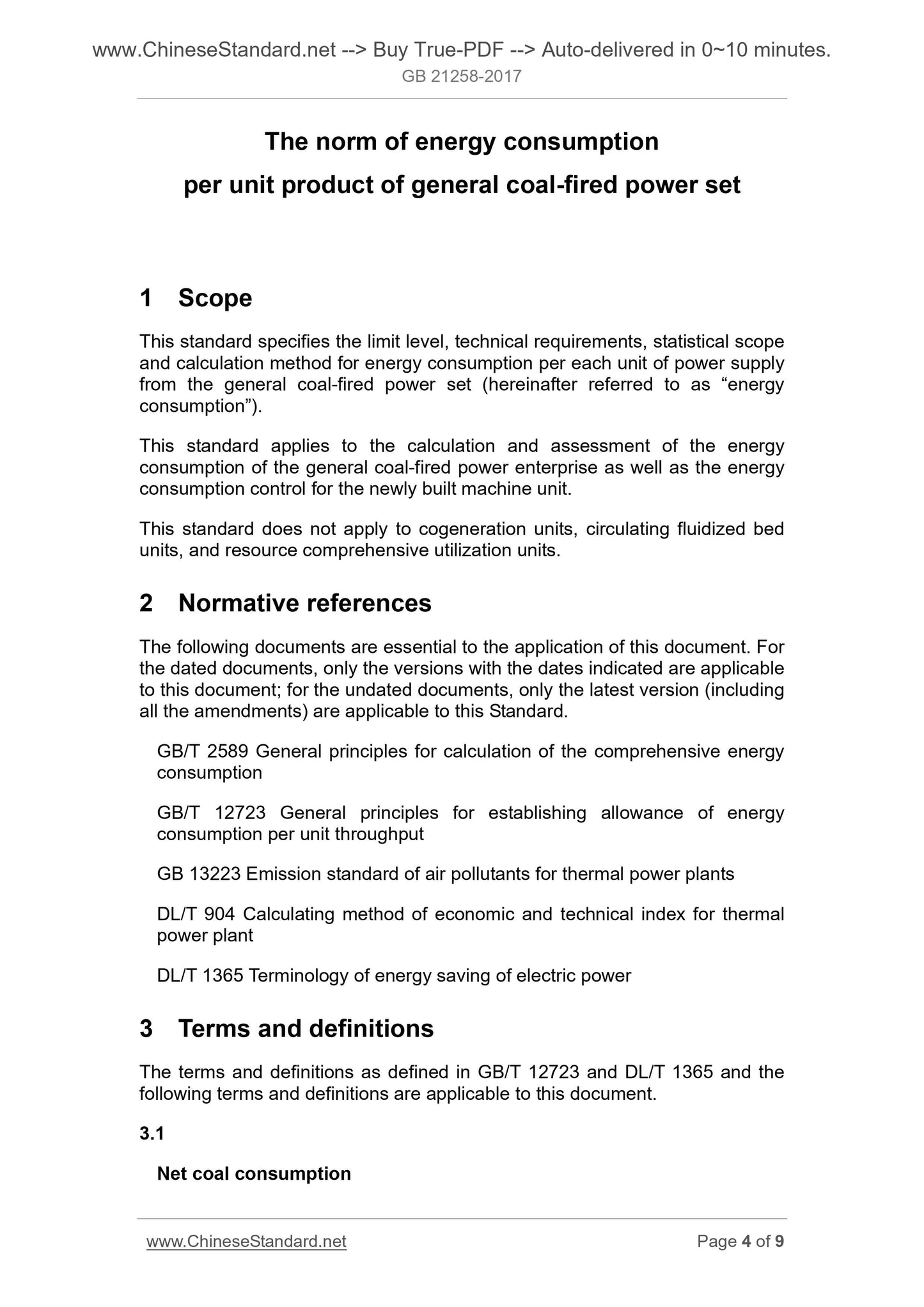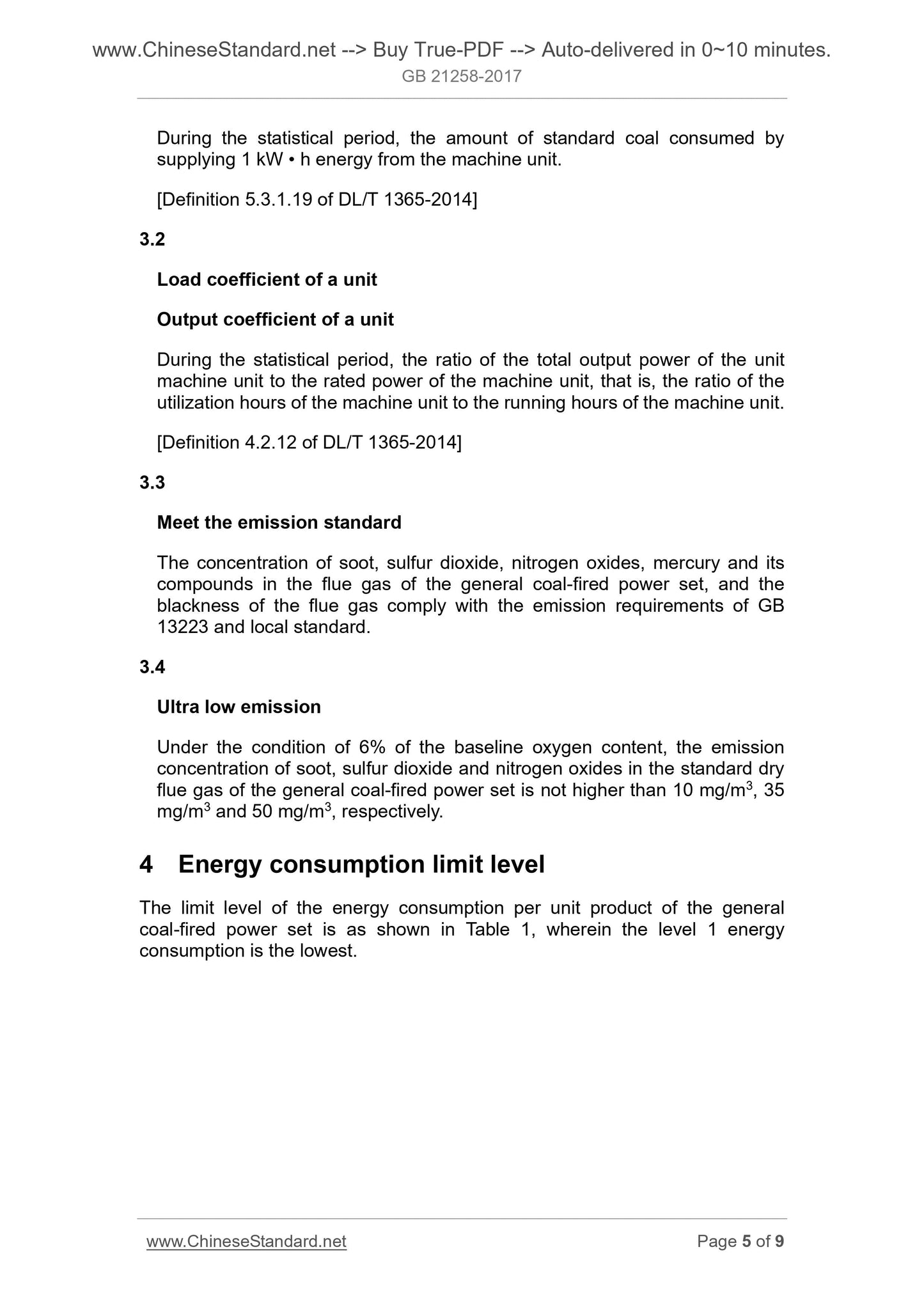1
/
of
5
PayPal, credit cards. Download editable-PDF & invoice In 1 second!
GB 21258-2017 English PDF
GB 21258-2017 English PDF
Regular price
$130.00 USD
Regular price
Sale price
$130.00 USD
Unit price
/
per
Shipping calculated at checkout.
Couldn't load pickup availability
Delivery: 3 seconds. Download true-PDF + Invoice.
Get QUOTATION in 1-minute: Click GB 21258-2017
Historical versions: GB 21258-2017
Preview True-PDF (Reload/Scroll if blank)
GB 21258-2017: The norm of energy consumption per unit product of general coal-fired power set
GB 21258-2017
GB
NATIONAL STANDARD
OF THE PEOPLE’S REPUBLIC OF CHINA
ICS 27.010
F 01
Replacing GB 21258-2013
The norm of energy consumption
per unit product of general coal-fired power set
ISSUED ON. MAY 31, 2017
IMPLEMENTED ON. DECEMBER 01, 2017
Issued by. General Administration of Quality Supervision, Inspection and
Quarantine of the People's Republic of China;
Standardization Administration of the People's Republic of
China.
3. No action is required - Full-copy of this standard will be automatically and
immediately delivered to your EMAIL address in 0~60 minutes.
Table of contents
Foreword ... 3
1 Scope ... 4
2 Normative references ... 4
3 Terms and definitions ... 4
4 Energy consumption limit level ... 5
5 Technical requirements ... 6
6 Statistical scope and calculation method ... 9
Foreword
This standard was drafted in accordance with the rules given in GB/T
1.1-2009.
This standard replaces GB 21258-2013 “The norm of energy consumption per
unit product of general coal-fired power set”. As compared with GB
21258-2013, the main changes are as follows.
- ADD the limit level of energy consumption per unit of product (SEE
Chapter 4);
- DELETE the “energy consumption advanced value” and “energy
management and measures”;
- MODIFY the energy consumption limits and energy consumption access
values indicators (SEE Chapters 4, clause 5.1 and 5.2; clause 4.1, 4.2 and
4.3 of 2013 version);
- ADJUST the correction factors of the impact factors of the limit level of
energy consumption per unit of product (SEE 5.3).
This standard was proposed by the National Development and Reform
Commission Resource Conservation and Environmental Protection Division,
and the National Energy Administration Energy Conservation and Technology
Equipment Division.
This standard shall be under the jurisdiction of the National Standardization
Management Committee.
The drafting organizations of this standard. China Electricity Enterprise
Association, Guodian Science and Technology Research Institute, China
International Engineering Consulting Company, China Huaneng Group
Corporation, China Huadian Corporation, Datang International Power
Generation Co., Ltd., North China Electric Power Research Institute Co., Ltd.,
Guangdong Electric Power Research Institute Energy Technology Co., Ltd.,
State Grid Hebei Electric Power Company Electric Power Research Institute.
The main drafters of this standard. Pan Li, Liu Zhiqiang, Pei Jie, Lun liyong,
Zhao Zhenning, Shen Yueliang, Chang Shuiping, Zhu Xian, Chen Feng, Tian
Ya, Xu Ning, Li Jinjing.
This Standard replaces the standard previously issued as follows.
- GB 21258-2007, GB 21258-2013.
The limit value of the energy consumption per unit product of the power set as
specified in this standard shall be implemented from January 1, 2019.
The norm of energy consumption
per unit product of general coal-fired power set
1 Scope
This standard specifies the limit level, technical requirements, statistical scope
and calculation method for energy consumption per each unit of power supply
from the general coal-fired power set (hereinafter referred to as “energy
consumption”).
This standard applies to the calculation and assessment of the energy
consumption of the general coal-fired power enterprise as well as the energy
consumption control for the newly built machine unit.
This standard does not apply to cogeneration units, circulating fluidized bed
units, and resource comprehensive utilization units.
2 Normative references
The following documents are essential to the application of this document. For
the dated documents, only the versions with the dates indicated are applicable
to this document; for the undated documents, only the latest version (including
all the amendments) are applicable to this Standard.
GB/T 2589 General principles for calculation of the comprehensive energy
consumption
GB/T 12723 General principles for establishing allowance of energy
consumption per unit throughput
GB 13223 Emission standard of air pollutants for thermal power plants
DL/T 904 Calculating method of economic and technical index for thermal
power plant
DL/T 1365 Terminology of energy saving of electric power
3 Terms and definitions
The terms and definitions as defined in GB/T 12723 and DL/T 1365 and the
following terms and definitions are applicable to this document.
3.1
Net coal consumption
During the statistical period, the amount of standard coal consumed by
supplying 1 kW • h energy from the machine unit.
[Definition 5.3.1.19 of DL/T 1365-2014]
3.2
Load coefficient of a unit
Output coefficient of a unit
During the statistical period, the ratio of the total output power of the unit
machine unit to the rated power of the machine unit, that is, the ratio of the
utilization hours of the machine unit to the running hours of the machine unit.
[Definition 4.2.12 of DL/T 1365-2014]
3.3
Meet the emission standard
The concentration of soot, sulfur dioxide, nitrogen oxides, mercury and its
compounds in the flue gas of the general coal-fired power set, and the
blackness of the flue gas comply with the emission requirements of GB
13223 and local standard.
3.4
Ultra low emission
Under the condition of 6% of the baseline oxygen content, the emission
concentration of soot, sulfur dioxide and nitrogen oxides in the standard dry
flue gas of the general coal-fired power set is not higher than 10 mg/m3, 35
mg/m3 and 50 mg/m3, respectively.
4 Energy consumption limit level
The limit level of the energy consumption per unit product of the general
coal-fired power set is as shown in Table 1, wherein the level 1 energy
consumption is the lowest.
Get QUOTATION in 1-minute: Click GB 21258-2017
Historical versions: GB 21258-2017
Preview True-PDF (Reload/Scroll if blank)
GB 21258-2017: The norm of energy consumption per unit product of general coal-fired power set
GB 21258-2017
GB
NATIONAL STANDARD
OF THE PEOPLE’S REPUBLIC OF CHINA
ICS 27.010
F 01
Replacing GB 21258-2013
The norm of energy consumption
per unit product of general coal-fired power set
ISSUED ON. MAY 31, 2017
IMPLEMENTED ON. DECEMBER 01, 2017
Issued by. General Administration of Quality Supervision, Inspection and
Quarantine of the People's Republic of China;
Standardization Administration of the People's Republic of
China.
3. No action is required - Full-copy of this standard will be automatically and
immediately delivered to your EMAIL address in 0~60 minutes.
Table of contents
Foreword ... 3
1 Scope ... 4
2 Normative references ... 4
3 Terms and definitions ... 4
4 Energy consumption limit level ... 5
5 Technical requirements ... 6
6 Statistical scope and calculation method ... 9
Foreword
This standard was drafted in accordance with the rules given in GB/T
1.1-2009.
This standard replaces GB 21258-2013 “The norm of energy consumption per
unit product of general coal-fired power set”. As compared with GB
21258-2013, the main changes are as follows.
- ADD the limit level of energy consumption per unit of product (SEE
Chapter 4);
- DELETE the “energy consumption advanced value” and “energy
management and measures”;
- MODIFY the energy consumption limits and energy consumption access
values indicators (SEE Chapters 4, clause 5.1 and 5.2; clause 4.1, 4.2 and
4.3 of 2013 version);
- ADJUST the correction factors of the impact factors of the limit level of
energy consumption per unit of product (SEE 5.3).
This standard was proposed by the National Development and Reform
Commission Resource Conservation and Environmental Protection Division,
and the National Energy Administration Energy Conservation and Technology
Equipment Division.
This standard shall be under the jurisdiction of the National Standardization
Management Committee.
The drafting organizations of this standard. China Electricity Enterprise
Association, Guodian Science and Technology Research Institute, China
International Engineering Consulting Company, China Huaneng Group
Corporation, China Huadian Corporation, Datang International Power
Generation Co., Ltd., North China Electric Power Research Institute Co., Ltd.,
Guangdong Electric Power Research Institute Energy Technology Co., Ltd.,
State Grid Hebei Electric Power Company Electric Power Research Institute.
The main drafters of this standard. Pan Li, Liu Zhiqiang, Pei Jie, Lun liyong,
Zhao Zhenning, Shen Yueliang, Chang Shuiping, Zhu Xian, Chen Feng, Tian
Ya, Xu Ning, Li Jinjing.
This Standard replaces the standard previously issued as follows.
- GB 21258-2007, GB 21258-2013.
The limit value of the energy consumption per unit product of the power set as
specified in this standard shall be implemented from January 1, 2019.
The norm of energy consumption
per unit product of general coal-fired power set
1 Scope
This standard specifies the limit level, technical requirements, statistical scope
and calculation method for energy consumption per each unit of power supply
from the general coal-fired power set (hereinafter referred to as “energy
consumption”).
This standard applies to the calculation and assessment of the energy
consumption of the general coal-fired power enterprise as well as the energy
consumption control for the newly built machine unit.
This standard does not apply to cogeneration units, circulating fluidized bed
units, and resource comprehensive utilization units.
2 Normative references
The following documents are essential to the application of this document. For
the dated documents, only the versions with the dates indicated are applicable
to this document; for the undated documents, only the latest version (including
all the amendments) are applicable to this Standard.
GB/T 2589 General principles for calculation of the comprehensive energy
consumption
GB/T 12723 General principles for establishing allowance of energy
consumption per unit throughput
GB 13223 Emission standard of air pollutants for thermal power plants
DL/T 904 Calculating method of economic and technical index for thermal
power plant
DL/T 1365 Terminology of energy saving of electric power
3 Terms and definitions
The terms and definitions as defined in GB/T 12723 and DL/T 1365 and the
following terms and definitions are applicable to this document.
3.1
Net coal consumption
During the statistical period, the amount of standard coal consumed by
supplying 1 kW • h energy from the machine unit.
[Definition 5.3.1.19 of DL/T 1365-2014]
3.2
Load coefficient of a unit
Output coefficient of a unit
During the statistical period, the ratio of the total output power of the unit
machine unit to the rated power of the machine unit, that is, the ratio of the
utilization hours of the machine unit to the running hours of the machine unit.
[Definition 4.2.12 of DL/T 1365-2014]
3.3
Meet the emission standard
The concentration of soot, sulfur dioxide, nitrogen oxides, mercury and its
compounds in the flue gas of the general coal-fired power set, and the
blackness of the flue gas comply with the emission requirements of GB
13223 and local standard.
3.4
Ultra low emission
Under the condition of 6% of the baseline oxygen content, the emission
concentration of soot, sulfur dioxide and nitrogen oxides in the standard dry
flue gas of the general coal-fired power set is not higher than 10 mg/m3, 35
mg/m3 and 50 mg/m3, respectively.
4 Energy consumption limit level
The limit level of the energy consumption per unit product of the general
coal-fired power set is as shown in Table 1, wherein the level 1 energy
consumption is the lowest.
Share
